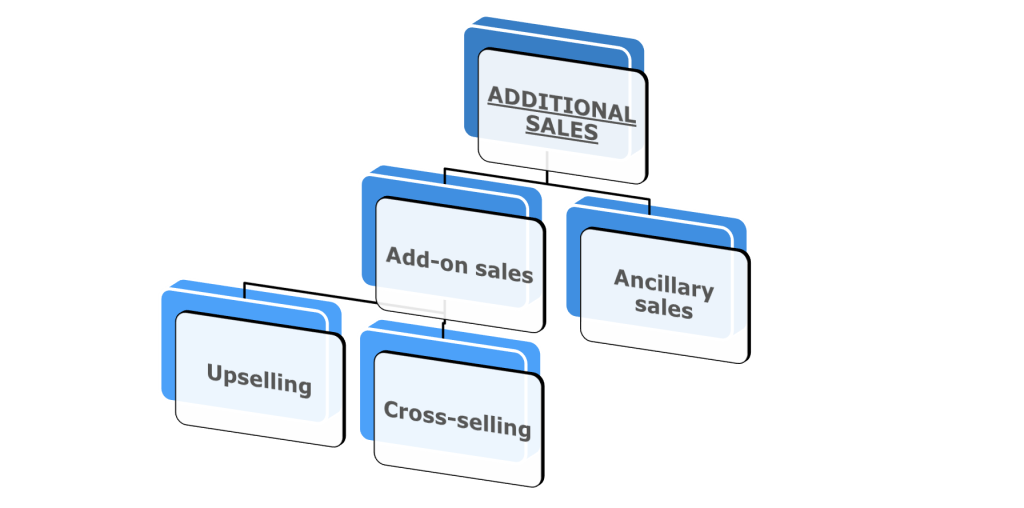
Additional Sales in Business-to-Business
Generating additional sales in a business-to-business (B2B) is crucial for the growth and success of many companies. It helps to increase revenue, expand market share, build stronger customer relationships, and improve overall profitability. Offering an excellent customer experience and finding customers true needs generate new sources of revenue that is a necessity in current economical atmosphere. Sales to business customers are partly different from ordinary consumer sales, but the basic elements in sales are similar. Should retailer analyse Business to business customer purchases and make sure that they are being served as well as regular customers?
Additional sales are commonly understood to be sales that are done to generate more value to the customers initial purchase. Additional sales support the main product or create various advantages for the initial purchase. These products and services may be logically tied to the initial product, such as baby formula is a logical additional product for diapers, or they might have a logical but not well-known binding to each other like a pillow and pillow protector. Additional products can be divided into two sub-categories: Add-on sales and ancillary sales. Add-on sales are further divided into two sub-categories, upselling and cross-selling.

Upselling is viewed to be an action to recommend and successfully sell a product that has higher quality or has some additional attributes than customers original choice had. Cross-selling is considered to be selling products that have a logical binding to the additional purchase. Cross-selling can be done even on a different occasion than upselling. Upselling is usually done when the initial purchase decision is also being made.
Ancillary sales have a binding to the focal product, but it does not have to be logical part of it. A good example is flight tickets and ancillary products for flight tickets. Better seating, a meal, additional luggage or lounge access are services that are not a necessity for people who purchase a flight ticket, but add a value to those who choose them.
Additional sales require engagement
Encountering customers and doing upselling and cross-selling is hard work. It requires talent to open a conversation with a customer so that they are not receiving the approach negatively. The salespeople who get past the first resistance of a customer tend to sell more additional products than others. In many instances, customers find themselves confronted with the task of weighing their preferences for quality, budget, and quantity. To foster additional sales, companies can strategically present customers with these options, so they can choose from multiple levels. If successful, this type of environment for options is a great opportunity for salespeople and key to additional sales success.
For management, understanding their business specific add-on sales environment is crucial. Upselling and cross-selling can be seen as a process of continuous decisions where previous purchasing decision has an effect on the next ones. This means that based on the level of service and experience, customers may think that an additional offer for better and more valuable item is overwhelming. Salespeople need to be aware how the initial decision was made before choosing how much they will push for add-on sales. While studies show that customer being overwhelmed by additional offers is usually not the case, it is important for management to study and decide what are the items and touchpoints that launch add-on sales process and what items are the pairs for each of these main products.
The best way to make sure that additional sales are being made, is the training of store employees and showing example. Key is to do additional sales as a part of great service, not as a learned, automated and joyless task that just needs to be done. Studies show that there are several ways to reach good results in additional sales but the most commonly known is by training.
Communication and finding the needs of the customer are vital for successful additional sale. Defining the customers needs require careful listening and understanding as well as acting accordingly. Salespeople need to know what the products that should be offered with each main product are and actively try to sell them. Companies that are successful in additional sales tend to wrap products in bundles and build salespeople knowledge of which product supports the initial purchase.
Measuring additional sales
To measure how additional sales are being made, companies need to understand their product portfolio and correlations in it. Retailers can easily create market basket types and determine what products customers are missing on their basket or what product groups are underrepresented. Similar comparison can be done by choosing the best performing or most valuable items and see what products are being sold together with them.
Beforehand decided product pairs are a commonly used way to analyse additional sales. By using pre-decided product pairs companies can see how additional sales are being made and what impact they might have. Following additional sales from reports and letting employees know about the goals companies can boost additional sales and keep them on top of employees minds.
Comparing B2B and retail
In B2B environment additional sales are done more commonly, perhaps because customers tend to buy in bulks. B2B customers may have a different approach for spending and they might see additional products as items that are great investments and support their initial purchase, where consumers see additional products more from the perspective of extra spending.
Bigger reason for better additional sales in B2B might be that the B2B customers can be recognized for example from their distinctive number of products that they are buying, their clothing or through conversations. This means that there is an easier and simple way for salespeople to open a conversation with customers, ask questions and listen to them carefully – serve them. A simple question of ”Business or private?” can launch an excellent conversation between two people and end up in a great solution – both for the seller and the buyer.
In his Master’s thesis, Additional sales in B2B – Implementing retail analysis methods for Business to Business operations Master Degree Student in Professional Sales Management Iivari Hovi has looked at what kind of additional sales type exist and what differences they have and how they are being analysed in retail organization. Using different research methods he found out that B2B customers are being served more thoroughly compared with B2B in pre-determined product pairs. As a result he presented solutions to generate more additional sales and pointed out that sales training helps companies to improve their additional sales.
References:
Friedman, Harry J. (2012) No Thanks, I’m Just Looking!: Sales Techniques for Turning Shoppers into Buyers. Wiley.
Hannila, H., Koskinen, J., Harkonen, J. and Haapasalo, H. (2020), ”Product-level profitability: Current challenges and preconditions for data-driven, fact-based product portfolio management”, Journal of Enterprise Information Management, Vol. 33 No. 1, pp. 214-237. https://doi-org.ezproxy.turkuamk.fi/10.1108/JEIM-05-2019-0127
Heidig, W., Wentzel, D., Tomczak, T., Wiecek, A. and Faltl, M. (2017), ”“Supersize me!” The effects of cognitive effort and goal frame on the persuasiveness of upsell offers”, Journal of Service Management, Vol. 28 No. 3, pp. 541-562. https://doi-org.ezproxy.turkuamk.fi/10.1108/JOSM-03-2016-0063
Vinod, B., Ratliff, R., & Jayaram, V. (2018). An approach to offer management: Maximizing sales with fare products and ancillaries. Journal of revenue and pricing management, 17(2), 91-101. https://doi.org/10.1057/s41272-017-0121-1
Yu, T., Patterson, P. & de Ruyter, J. (2015). Converting service encounters into cross-selling opportunities Does faith in supervisor ability help or hinder service-sales ambidexterity? European journal of marketing, 49(3-4), pp. 491-511. doi:10.1108/EJM-10-2013-0549